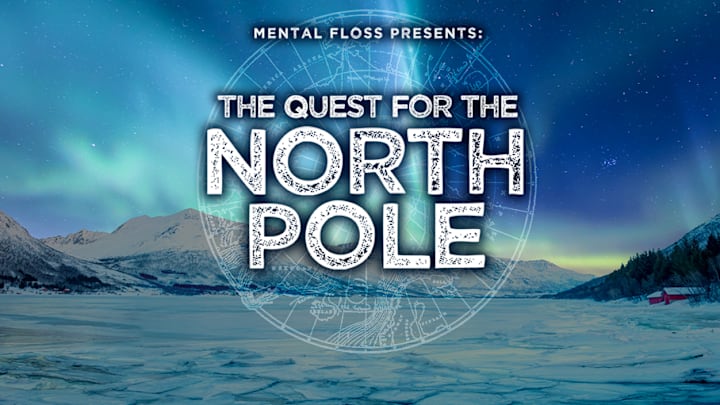Learning the history of polar exploration can feel like a bit like navigating a foreign language. The adventurers who traversed the farthest regions of our planet had their own vocabulary to describe the risks, tools, and geography they encountered. Before listening to our new podcast The Quest for the North Pole, familiarize yourself with these polar terms. (Don't forget to subscribe here, or by clicking subscribe above!)
1. Degrees and Minutes
Units of longitude and latitude. One minute equals one nautical mile. There are 60 minutes in a degree, so one degree of latitude or longitude equals 60 nautical miles. The North Pole is located at 90° North Latitude, the Equator is at 0° Latitude, and the South Pole is at 90° South Latitude.
2. Frostbite
An injury that occurs when skin is exposed to windy, freezing conditions. In extreme cold, skin tissue can freeze and sustain permanent damage if not treated quickly. Severe frostbite can lead to loss of fingers or toes when the tissue dies.
3. Glacier

A massive, slow-moving body of ice that forms on land through centuries of snow accumulation. Over time, the snow is compressed into ice and flows toward sea level. Glaciers are much thicker than sea ice.
4. Hummock
An elevated mound made of broken ice that has been forced upward, such as by the pressure of two ice floes crashing together. The opposite—a hummock forced downwards—is called a bummock.
5. Ice Floe
A large, flat sheet of free-floating sea ice that measures at least 60 feet in diameter.
6. Ice Pressure
The force exerted on ships by moving pieces of ice at sea. Large pieces of ice moving toward each other could catch a ship between them, causing damage to or sinking the vessel.
7. Iceberg
A large, floating mass of ice that has broken off (or calved) from a glacier.
8. Inuit, Inughuit
The people indigenous to Inuit Nunangat—the land, water, and ice of Arctic Canada—as well as the Arctic regions of Greenland, Russia, and Alaska. Inughuit are the people native to northwestern Greenland, specifically. Inuit and Inughuit mean “the people” in dfferent dialects of Inuktitut, the language spoken by many Inuit.
9. Kayak

An Inuit boat used for hunting, traditionally constructed of a wooden frame covered with seal or walrus skin. Kayaks have a seat for one person and a covered deck to protect the paddler from waves and water spray.
10. Lead
A channel of open water separating sea ice. Leads are considered spaces of water too wide to jump across and can range in width from several feet to more than a mile [PDF].
11. Nautical Mile
A unit of measurement used in air and sea navigation, equal to 1.1508 statue miles or 6076 feet. It’s what latitude and longitude are measured in.
12. Pack Ice
A large expanse of sea ice consisting of smaller, broken pieces of different shapes and thicknesses. The pack can be described as close (with pieces crammed together) or open (with pieces spaced more widely), depending on the concentration of ice [PDF].
13. Pemmican
A concentrated paste, usually shaped into blocks, consisting of roughly equal parts fat and dried, pulverized meat. It originated with Native Americans and was later used as high-energy rations on polar expeditions.
14. Scurvy

An illness caused by vitamin C deficiency, with symptoms including fatigue, soft or discolored gums, loose teeth, bruising, and bleeding from the skin. Scurvy afflicted countless sailors and explorers on long expeditions, when fresh food containing vitamin C was unavailable.
15. Sea Ice
Seawater that has frozen on the ocean’s surface. It can form different shapes, from tiny pellets to vast fields.
16. Sextant
An instrument designed to measure angles. Navigators used it to gauge the distances between celestial bodies, such as the sun, earth, and stars.
17. Ship's Biscuit
Also known as hard tack. Ship's biscuit is a cracker-like bread that's baked from a stiff dough and left to dry out and harden. Because it had a long shelf life, it was an essential part of seamen’s diets prior to modern canned foods.
18. Sledge

A sturdy sled used for transporting people and goods over icy and snowy terrains. They can be pulled by people, dogs, or reindeer.
19. Statute Mile
The name for the standard, 5280-foot mile used to measure distance on land.
20. Trade Goods
Items that white explorers traded with Native people for their products or services. Trade goods were useful articles that were otherwise hard to find in the Arctic, such as needles, knives, and other metal wares.
21. Umiak
A large, open boat consisting of a wooden frame covered in walrus hide. Inuit used these lightweight but strong boats to transport multiple passengers and goods.
